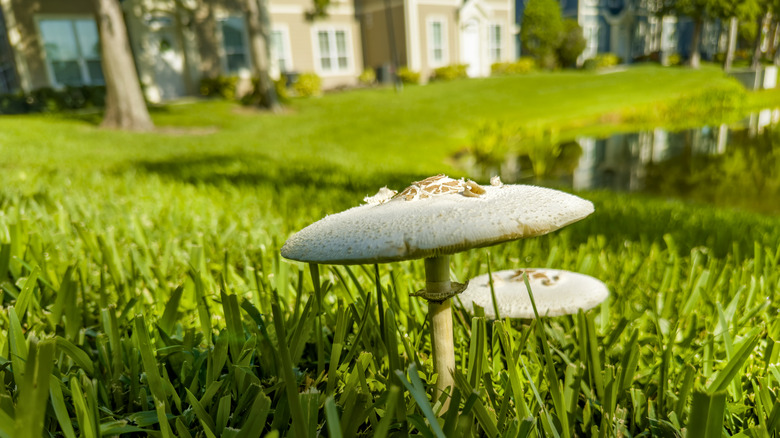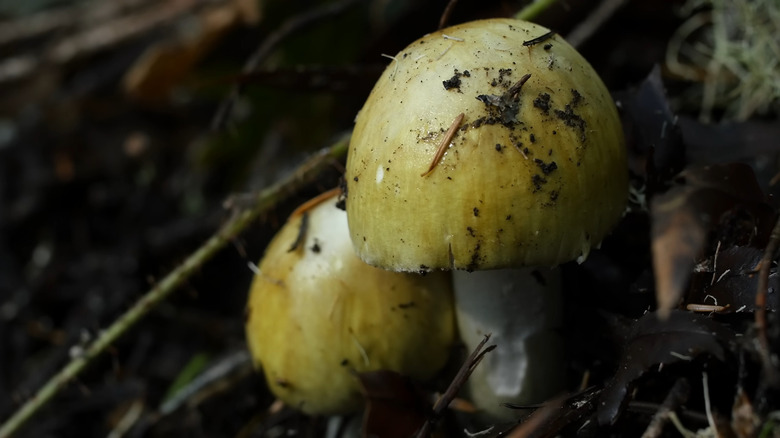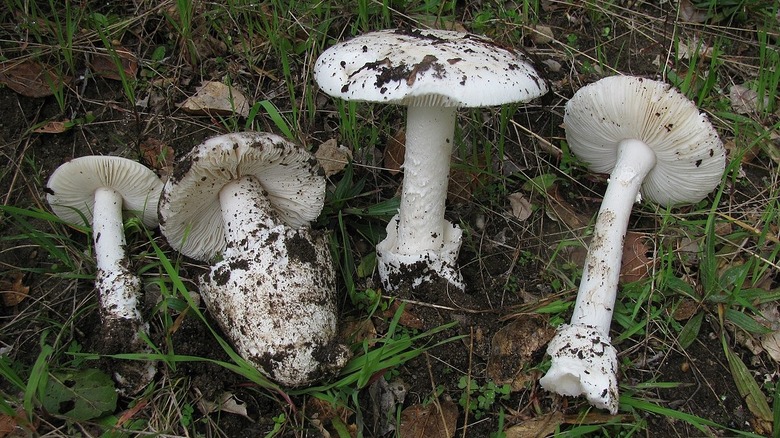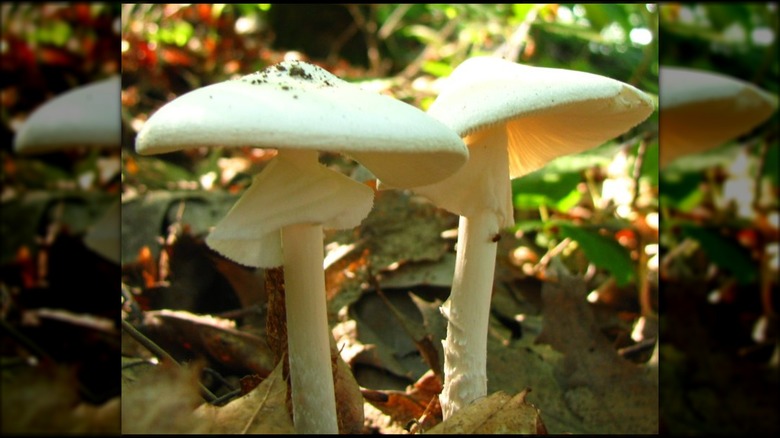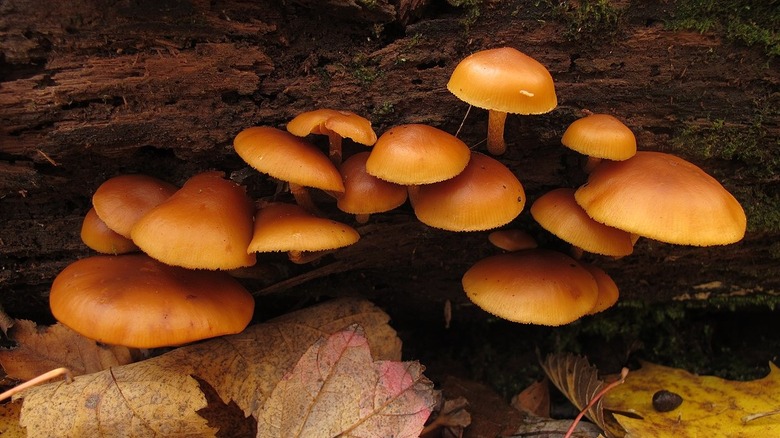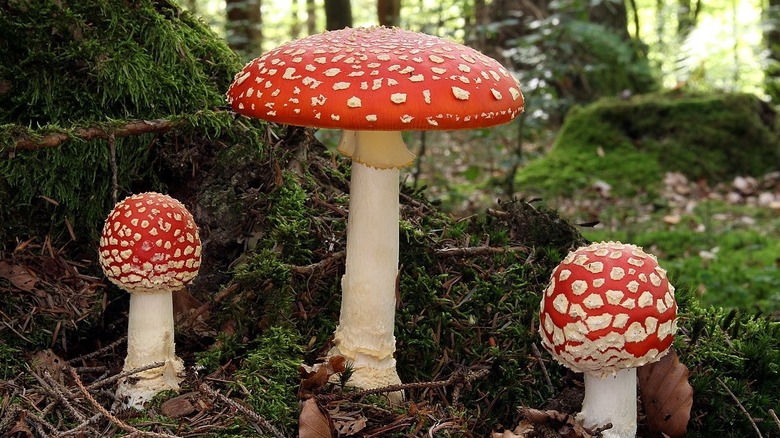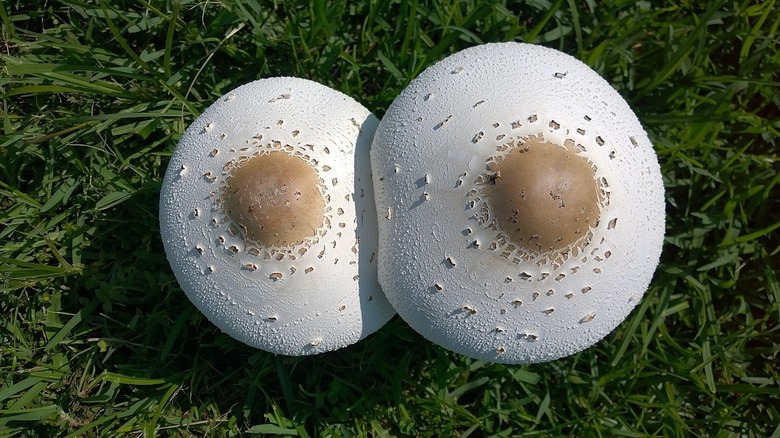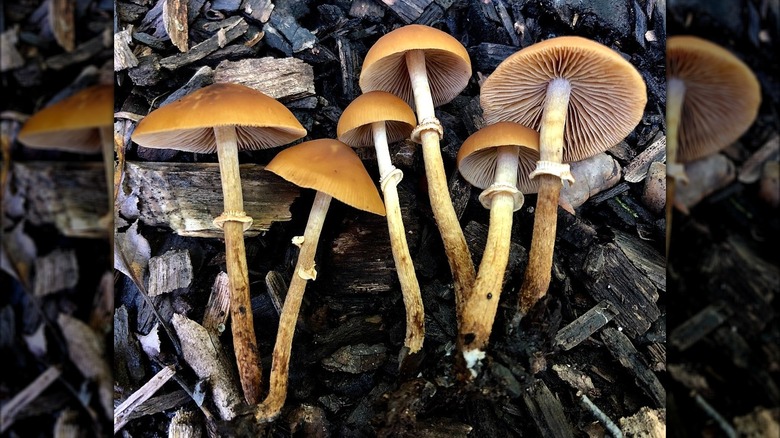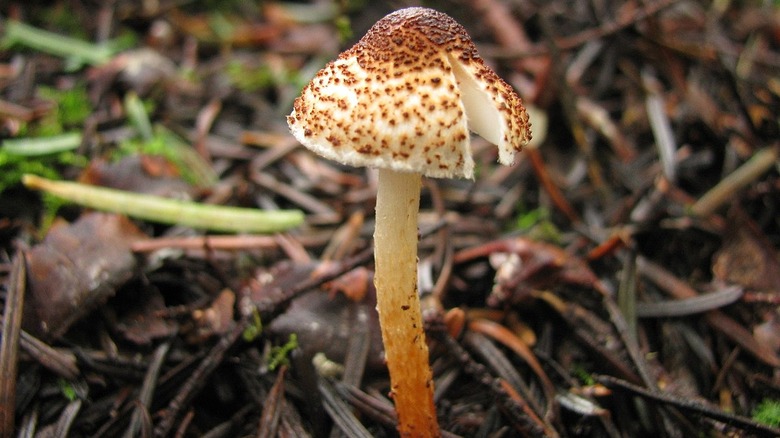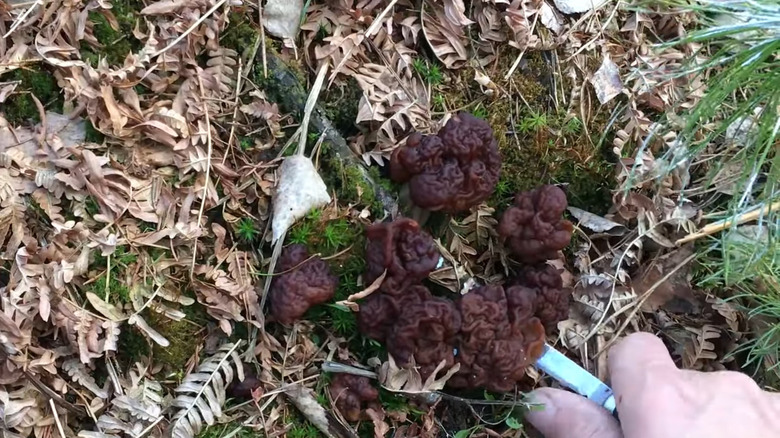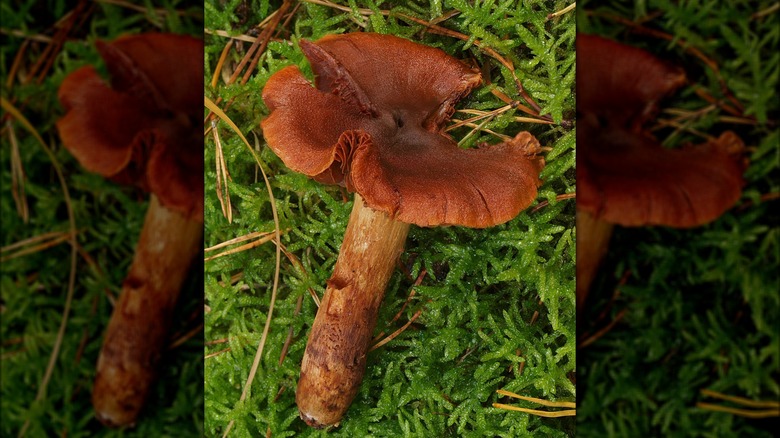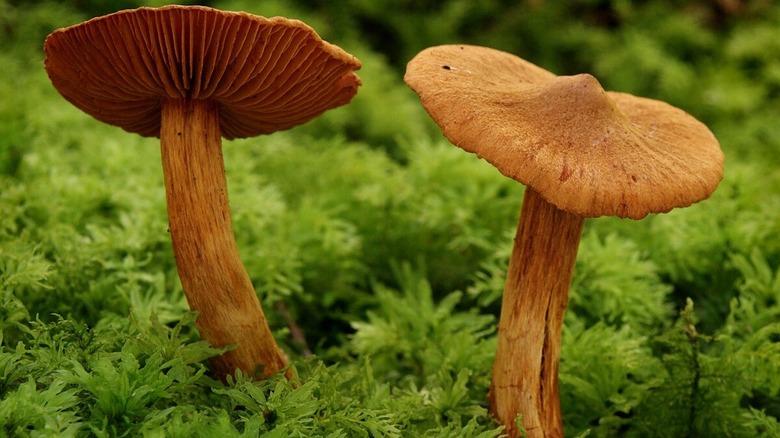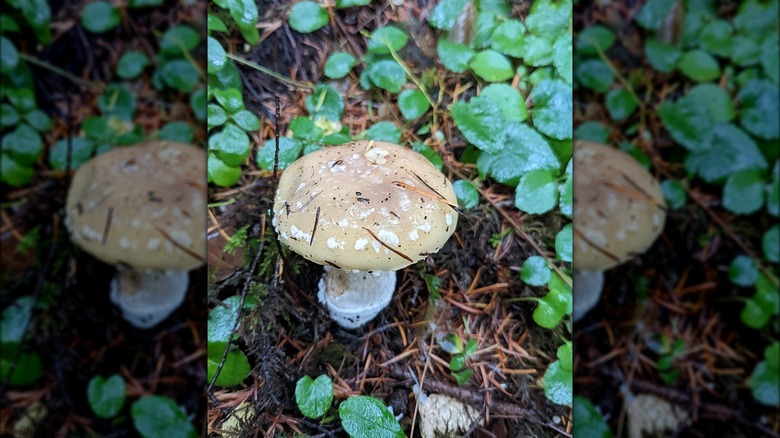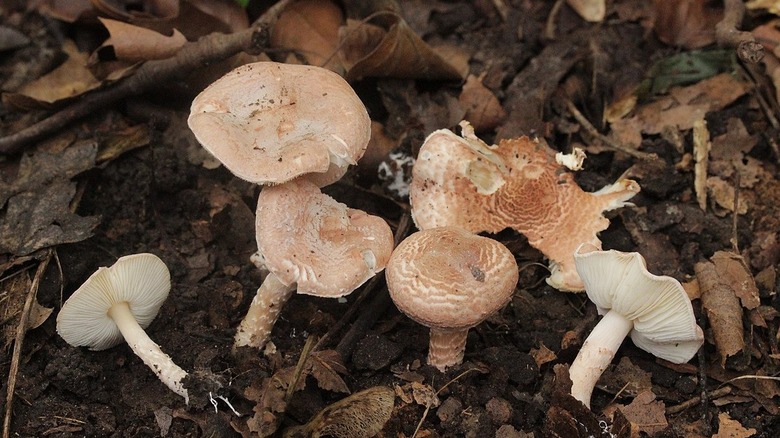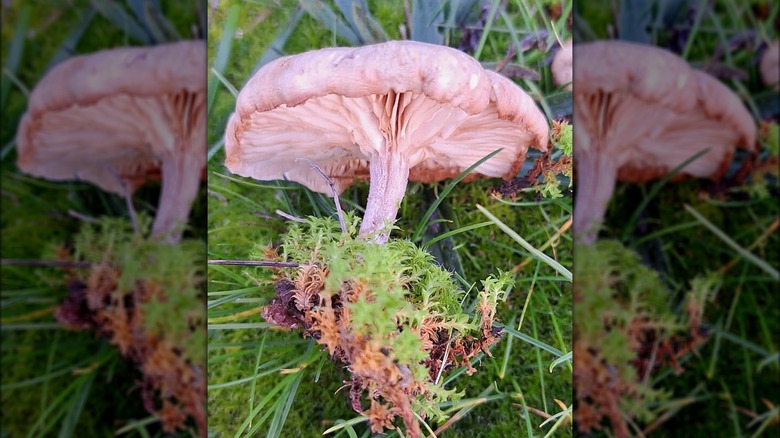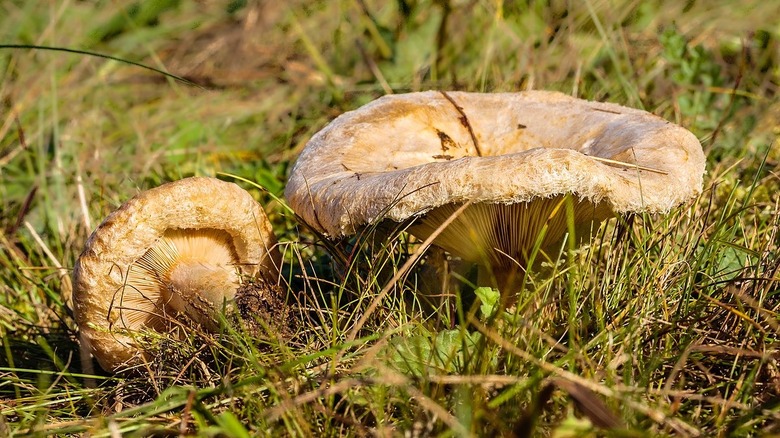15 Deadly Mushrooms That Could Be Growing In Your Backyard
A good deal of rain achieves more than quenching your plants' thirst. It also instigates mushrooms to sprout in your yard and monopolize the available organic content. While the growth of these fungal fruiting bodies is akin to receiving a stamp of approval for your soil's health, such stamps could be quite expensive and fatal in some cases. Unlike the creamy-white mushrooms you're used to buying off the grocery shelves, the organisms growing in your backyard aren't always as innocuous, regardless of how benign they look. Gorging on wild mushrooms has caused many to lose their lives or suffer permanent neurological damage, as poisonous mushrooms can cause abdominal pain, diarrhea, and liver damage.
Medscape estimates over 100 mushroom species are responsible for most cases of poisoning in humans, with at least 15 being downright deadly. Most cases of mushroom toxicity can be attributed to the Amanita species, with Lepiota and Galerina varieties included as well. Since it's extremely difficult to differentiate the good ones from the bad, even for the experts, it's recommended to steer clear of the mushrooms foraged from your lawn. The rule applies even if a mushroom ID app suggests otherwise, as they do not have access to all information (like smell), resulting in life-threatening identification errors. So, get rid of mushrooms in your lawn, especially if they belong on the list below, lest they get the better of an inquisitive child or a pet.
Death cap mushroom (Amanita phalloides)
Death cap mushrooms came to the U.S. when a European cork oak was imported to North America. Since then, they've spread their spores along the Pacific and drummed up a friendship with hardwood species. They appear right after the first fall rains and maintain a continuous presence in well-irrigated yards. With umbrella-shaped, greenish-brown caps and yellowish gills on the underside, you can spot this deadly mushroom in your yard from the white ring and sac around the stem and the base. Signs of liver damage will likely appear 12 hours after consumption.
Western destroying angel (Amanita ocreata)
Western destroying angel shares uncanny similarities to its "death cap" cousin despite being a Californian native, not an introduced species. From top to bottom, its rings are a uniform white (although the loops vanish as the shrooms age), and it can be seen near oak, pine, or hazel trees. It contains lethal doses of amatoxins. Fortunately, this type isn't as prolific, appearing only during the transitory period of late winter to early spring. If a mushroom's white cap turns yellow after being dunked in a diluted solution of potassium hydroxide, you're dealing with an Amanita.
Two-spored/Eastern destroying angel (Amanita bisporigera)
Spreading its fungal spores from New York to Texas, Amanita bisporigera is a scourge in the eastern states. Its poisonous amanitins are capable of damaging a human's liver and kidneys and leading to death in seven days when untreated. The 5-inch tall fungus supports a cottony-white cap that grows a tan-yellow or pastel-pink center when exposed to dry weather conditions or with maturity. Its aromatic presence might scream "food," but it's not. Pearly-white volvas may be absent sometimes, but the cap will fail the aforementioned potassium hydroxide test by turning yellow.
Autumn skullcap (Galerina marginata or autumnalis)
A lover of decomposed lumber, autumn skullcap inhabits conifer or other broadleaf trees of North Carolina and is a good representation of why you should keep away from brown shrooms since it's hard to distinguish from their hallucinogenic counterparts. With a 1½-inch wide, chocolate-brown, nearly-flat cap, tinged honey-yellow along the margins, and standing atop a creamish-tan stalk, the autumnalis variety has a striking presence from summer until fall. However, it poses an immense risk to human health thanks to its amatoxins that cause a breakdown of bodily functions after six hours of ingestion.
Fly agaric (Amanita muscaria)
The fly agaric is a psychoactive mushroom with a long, ritualistic history among Northern European and Asiatic peoples, eventually making its way to the temperate North American continent. Its characteristic gorgeous, orangish-red caps interspersed with milky-white splotches (featured in "Super Mario"!) congregate in the roots of spruce and fir trees, which is why it's associated with Christmas and winter solstice. However, rain may wash down the milky spots, making them harder to spot. It's considered deadly for its toxic alkaloids, including muscimol and muscarine, that hamper breathing and ingestion when consumed raw in excessive amounts.
Green-spore poison parasol (Chlorophyllum molybdites)
The only large mushroom of its kind fruiting green spores, the green-spored parasol has marked its presence all over North America, especially the Great Plains. It's easy to mistake for the relatively benign meadow mushroom in its early stages, as both have conical white caps marked in cinnamon scales. However, as the shroom matures, its cap assumes brown tinges with greener gills, making it easier to spot. Its propensity to grow in troops or develop as fairy rings in lawns is another giveaway. While not lethally harmful for adults, it can make young kids sick.
Pholiotina rugosa (formerly Conocybe or Pholiotina filaris)
Sitting tight with the "little brown mushroom" tribe, Pholiotina rugosa is often confused with the ostensibly bigger "autumn skullcap." However, this one is recognizable by its tissue ring at the stem's top end. It has a bell-like, satin-textured, wrinkled, sienna-toned cap with sepia gills. Don't be fooled by its small size, though, as it is extremely poisonous due to noxious amatoxins. It's commonly found growing in troops among decomposing conifer wood and tufts from fall until midwinter in the regions lying between California and Alaska, and also from Michigan to the Adirondacks.
Chestnut dapperling (Lepiota castanea)
Joining the league of the Amanita species, the Lepiota variety has been held responsible for the untimely deaths of several mushroom foragers, owing specifically to its amatoxins causing a delayed onset of liver damage. Widely distributed along the eastern and western coasts, these fungi love devouring and decomposing organic matter — such as those found in backyards and lawns. They boast reddish-fawn, shaggy caps with creamy-white gills that later take on reddish shades with age. Their beige stems turn reddish as they inch closer to the soil but won't have volvas.
False morel (Gyromitra esculenta)
A sought-after delicacy, false morels are another mushroom that shouldn't make it to your dinner barbeque. Although most believe boiling them deactivates the "gyromitrin" toxin notorious for damaging red blood cell count and the nervous system, this isn't always the case. Moreover, breathing in the toxic chocolatey odor as false morels are boiled can cause illness as well. Initially smooth, their reddish-brown cap appears as an intricate, sometimes hollow, brain-like web and is much larger than their pale stem. Mostly ubiquitous in mountainous regions around spring.
Fool's webcap (Cortinarius orellanus)
Fool's webcap has a toxic compound, orellanine, that can gestate in the body for a long time before escalating into end-stage renal failure and death. Often confused with the delicious chanterelle mushroom, this toadstool has an attractive, albeit dry demeanor with a light brown cap that increasingly turns pinkish-reddish toward the center. It has a similarly brownish-red stem, although the colors are muted compared to the cap and the yellowish-red gills. Reeking of radish, they are endemic in the temperate north, collecting under conifers and hardwood trees.
Deadly webcap (Cortinarius rubellus)
Found along eastern and western American coasts, deadly webcap is incredibly poisonous and fatal even when consumed only in small bites. This is because it holds high doses of orellanine, a nephrotoxic compound known to severely damage the liver and kidneys. Like its webcap counterparts, it has a dry, scaly texture with an orange cap developing a protruding brown umbo (raised center) later. But you can tell the two apart from the serpentine, yellow patterns on the rubellus' stems. You'll often find it in moist, acidic soils, colonizing yards from late summer to fall.
Western panther amanita (Amanita pantherinoides)
Although western panther amanita varies in appearance and habitat, there's no debating it's extremely poisonous: enough to instigate a coma, if not death. This is generally a result of muscimol and ibotenic acids that react with the nervous system. Supporting a tawny, white warts-ridden cap on a mostly white stem at maturity, pantherinoides produce an elliptical, white spore print. It boasts a rounded brown head in the early stages. It's usually found amongst Douglas fir and Monterey pine trees from fall to winter along the Pacific Northwest region.
Deadly parasol (Lepiota subincarnata)
By emitting a fruity aroma and matching its appearance to the prized fairy ring mushrooms, the deadly parasol has roped in numerous gardeners to consume them. But the taste costs them dearly, as these shrooms enclose cyclic peptides and amatoxins in their pink-centered, brownish-white caps that cause liver failure and bodily breakdown within 10 days of intake. Other distinct features include a pale stem covered in a similarly toned felt material on its lower sections and concentrically running tawny bands across the toadstool's head. It's found in mulch, with a pronounced presence in Washington and Oregon.
Fool's funnel (Clitocybe rivulosa)
Also called Clitocybe dealbata, given the lack of differentiating characteristics between the two types, fool's funnel has one lesson to teach: avoid unknown white-gilled mushrooms. Unfortunately, many fall for this sweet-smelling toadstool that forms fairy rings in lawns among grassroots and loves to mix in with edibles from summer until fall. Watch out for white, inrolled caps with a central depression (rather than an umbo), as they contain dangerous levels of muscarine, raising the risk of premature death if consumed. The small caps fissure during hot weather, while the gills grow grayish-pink with age.
Brown rollrim (Paxillus involutus)
Truly one-of-a-kind, brown rollrim has aced the art of waiting, going down in history as the mushroom that caused the untimely demise of Julius Schäffer, a distinguished mycologist. What makes it different is that it works cumulatively — the more you eat it, the more it eats away at your body (red blood cells, in particular), with the effects becoming prominent over time. Its knack for absorbing soil-present mercury adds to its toxicity. So steer clear of any green-tinged, grooved, brown-capped mushroom growing in your backyard. Their tan gills turn brownish-red when touched.
